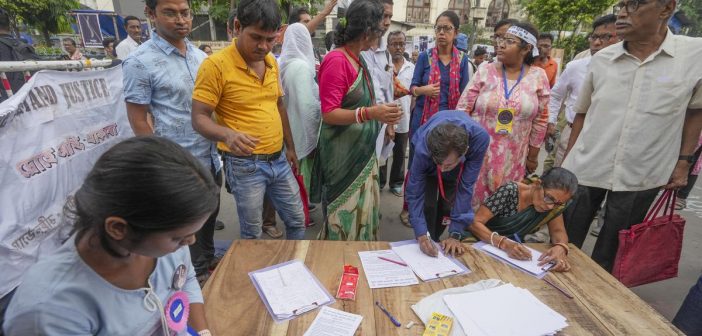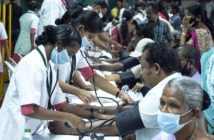West Bengal’s healthcare system finds itself in a precarious situation as doctors continue their hunger strike, spurred by the BG Kar Medical College case. The state government’s failure to resolve the impasse has only exacerbated the crisis, impacting not just the healthcare community but the public at large. The strike, now extending beyond a week, is becoming a symbolic protest against administrative inefficiency, workplace injustice, and the lack of support from the government in addressing healthcare professionals’ concerns.
The BG Kar Medical College Case: Catalyst for a Larger Movement
The trigger for the ongoing strike stems from the administrative dispute at BG Kar Medical College, one of West Bengal’s premier medical institutions. Junior doctors have been protesting against what they claim is “administrative harassment” and an oppressive working environment, where their concerns about infrastructure, security, and overwork are routinely ignored. The immediate flashpoint was the suspension of a doctor over allegations of medical negligence, an action that many in the medical fraternity saw as unfair and politically motivated.
This case isn’t an isolated incident; it reflects a broader issue of deteriorating working conditions for medical professionals in government hospitals across West Bengal. Overcrowded wards, a lack of basic medical supplies, and an absence of security measures have pushed doctors, especially junior ones, to their breaking point. The BG Kar case has now become a symbol of the systemic problems plaguing the state’s healthcare system, resulting in widespread protests.
Growing Discontent and the Hunger Strike
Following weeks of unaddressed grievances, several doctors, including interns, resident doctors, and junior staff from BG Kar and other medical colleges, launched an indefinite hunger strike. The hunger strike has garnered significant attention, not only from the medical fraternity but also from political and social groups who are beginning to see the issue as emblematic of the larger failure of the state government.
Doctors have expressed their frustration with the state’s inability to address their demands for better working conditions, protection from violence, and the withdrawal of punitive measures against medical staff. While healthcare professionals often work in difficult environments, the hunger strike highlights the sheer extent of their disillusionment, which is now moving toward a more organized form of resistance.
Government Inaction: A Cause for Concern
The state government, led by Chief Minister Mamata Banerjee, has so far been unable to bring a resolution to the crisis. Despite several meetings between health department officials and representatives of the doctors, no concrete steps have been taken to address the root causes of the strike. The government’s stance has been perceived as both dismissive and reactive, rather than proactive in finding a solution to the ongoing impasse.
This impasse is further complicated by the state’s healthcare politics, where any criticism or protest is seen through the lens of political opposition rather than genuine concern. The result is a healthcare crisis that is allowed to fester, while the state apparatus remains locked in a bureaucratic and political stalemate. The absence of effective negotiation has meant that not only are the doctors’ demands unmet, but the crisis is also deepening by the day.
Impact on Public Health
The ongoing hunger strike and general discontent among healthcare professionals have led to significant disruptions in healthcare services across the state. Outpatient services (OPD), surgeries, and emergency care in several government hospitals have been severely affected, with junior doctors and interns on strike, leaving senior staff overstretched. Reports from various districts indicate that several medical colleges and hospitals are functioning with skeletal staff, while patients are being turned away or left unattended for extended periods.
According to some estimates, nearly 40% of healthcare services in government hospitals have been impacted due to the strike, with the situation worsening each passing day. Public frustration is growing as patients face delays in receiving treatment, particularly in specialized medical services. This situation has disproportionately affected the poor and marginalized communities, who rely heavily on government hospitals for healthcare. The longer the strike continues, the more the public health system in the state is at risk of collapsing.
Unmet Demands: A Stalemate Without Resolution
The key demands of the protesting doctors include:
- Improved Security: In light of frequent incidents of violence against healthcare professionals, doctors are demanding adequate security measures in hospitals. They want the state government to implement stricter laws and provide police protection in high-risk areas.
- Better Infrastructure: Doctors have pointed to the crumbling infrastructure in government hospitals, where basic equipment and essential medicines are often in short supply. They are calling for the government to increase funding and improve hospital facilities to ensure proper treatment for patients.
- Revoking Punitive Measures: One of the most immediate demands is the withdrawal of suspensions and disciplinary actions against doctors accused of negligence without due process. Medical professionals argue that they are being unfairly targeted when systemic failures are often to blame.
- Addressing Overwork and Burnout: Overworked staff and long shifts are common in many government hospitals, and doctors are asking for regulations that would ensure better work-life balance and prevent burnout.
What Needs to Be Done: Possible Solutions
The state government must step up its efforts to resolve the deadlock before the healthcare system collapses entirely. Here are some potential steps to mitigate the crisis:
- Immediate Dialogue and Mediation
The government must initiate a serious dialogue with the protesting doctors, led by an independent mediator if necessary. The current ad hoc meetings have failed to yield results, and it’s essential that both sides approach the negotiation table with a genuine commitment to finding common ground. - Improving Hospital Security
Installing CCTV cameras, increasing police presence, and enforcing strict laws against violence in hospitals can provide immediate relief to healthcare workers who feel threatened. West Bengal should consider adopting models used in states like Maharashtra, where the “Protection of Medicare Service Persons and Medicare Service Institutions (Prevention of Violence and Damage to Property) Act” has been effective. - Infrastructure Overhaul
The state must immediately allocate emergency funds to improve the basic infrastructure in hospitals. Overcrowded wards, lack of essential medicines, and inadequate equipment need to be addressed to prevent further deterioration of patient care. - Fair Disciplinary Procedures
There should be a fair and transparent mechanism for investigating allegations of medical negligence, where healthcare professionals are not unduly punished without due process. Establishing independent medical review boards can help in evaluating such cases fairly. - Relieving Work Pressure
Addressing overwork and long shifts by employing more medical staff and ensuring that existing employees have reasonable work hours can prevent burnout and improve the overall healthcare environment.
Conclusion
The doctors’ hunger strike in West Bengal represents a critical juncture in the state’s healthcare crisis. The BG Kar case has brought to the fore the deep-rooted issues plaguing government hospitals, including poor infrastructure, lack of security, and overburdened staff. The state government’s inability to resolve the impasse is not only affecting the medical community but also the wider public, particularly those dependent on public healthcare.
The government must act swiftly and decisively to end the stalemate, addressing the legitimate concerns of healthcare professionals while ensuring that the public health system is not further compromised. If left unresolved, this strike has the potential to spiral into a larger healthcare disaster, with long-term repercussions for the state’s already strained medical infrastructure.






